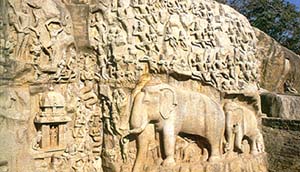|
|
|
Mahabalipuram

Also known as Mahabalipuram, this ancient sea port was built by Emperor Mahendravarman Pallava in the 7th century. From here ships left for countries in south-east Asia and the Mediterranian carrying not only traders but people who emigrated to countries like Indonesia, Thailand and Combodia. Over the passage of time Mamallapuram ceased to function as a port but its glory lived on in its finished and unfinished temples and monuments. Time and natural forces have wrought changes onthe solid rock surface of these monuments but each sculpture and image still succeeds in conveying a message of beauty and harmony. Mamallapuram bears testimony and pays tribute to its Pallava artists and to the culture of South India. Among the places of interest are Arjuna's Penance, Krishna Mandapa, Mahishasuramardini Cave, Mandapams, Pancha Rathas, Shore Temple and Varaha Mandapa.
World famous for its shore temples, Mahabalipuram, was the second capital of the Pallava kings of Kanchipuram. 58 kilometres from Madras on the Bay of Bengal, this tiny sea side village of Mahabalipuram, is set in a boulder strewn landscape. Tourists are drawn to this place by its miles of unspoiled beach and rock-cut art. The sculpture of this place, is particularly interesting, because it shows scenes of day-to- day life, in contrast to the rest of the state of Tamil Nadu, where carvings generally depict gods and goddesses. Mahabalipuram art is divided into four categories : open air bas reliefs, structured temples, man-made caves and rathas ('chariots' carved from single boulders, to resemble temples or chariots used in temple processions). The famous Arjuna's Penance and the Krishna Mandapa, adorn massive rocks near the centre of the village. The beautiful Shore Temple towers over the waves, behind a protective breakwater. Sixteen manmade caves in different stages of completion, are also seen scattered through the area.
|
| Kanchipuram |
|
| Around Chennai
|
|